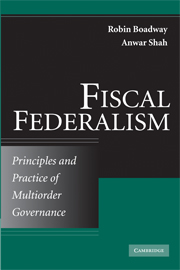Book contents
- Frontmatter
- Contents
- Preface
- PART ONE DESIGNING FISCAL CONSTITUTIONS
- PART TWO REVENUE SHARING AND FISCAL TRANSFERS
- 8 Revenue Sharing
- 9 The Principles of Intergovernmental Transfers
- 10 The Practice of Intergovernmental Transfers
- PART THREE FINANCE AND PROVISION OF PUBLIC SERVICES
- PART FOUR CHALLENGES AND RESPONSES
- References
- Index
9 - The Principles of Intergovernmental Transfers
Published online by Cambridge University Press: 05 June 2012
- Frontmatter
- Contents
- Preface
- PART ONE DESIGNING FISCAL CONSTITUTIONS
- PART TWO REVENUE SHARING AND FISCAL TRANSFERS
- 8 Revenue Sharing
- 9 The Principles of Intergovernmental Transfers
- 10 The Practice of Intergovernmental Transfers
- PART THREE FINANCE AND PROVISION OF PUBLIC SERVICES
- PART FOUR CHALLENGES AND RESPONSES
- References
- Index
Summary
THE TYPES OF TRANSFERS AND THEIR PURPOSE
Federal-state transfers are an important feature of all federations, and their analogue is used in nonfederal countries that have multiple levels of government as well. These transfers form part of a broader system of fiscal relations between the federal and state levels of government. We begin this introductory section by outlining the forms that transfers can take before turning to the rationale for federal-state transfers. In what follows, we use the terms “transfers” and “grants” interchangeably.
Forms of Intergovernmental Transfers
Intergovernmental transfers form part of the system of federal-state fiscal arrangements that are in place to coordinate fiscal decision making at the two highest levels of government, federal and state. Federal-state fiscal relations consist primarily of a set of financial transfers from the federal government to the states and a set of arrangements for coordinating and sharing particular tax bases. There may also be federal-state agreements on fiscal issues, such as agreements on internal trade, agreements to coordinate the exercise of policy responsibilities that are jointly occupied by the two levels of government (e.g., environmental polices), and interactions between the governments through regulations. In principle, the two levels of government could be financially independent and separate, but that is typically not the case. The federal government will generally collect more tax revenues than it needs for its own purposes and transfer some of the excess to the states either as grants or by the explicit sharing of tax revenues. This outcome reflects the fact that, while it may be efficient to decentralize expenditure responsibilities to a considerable extent, it is less efficient to decentralize revenue raising.
- Type
- Chapter
- Information
- Fiscal FederalismPrinciples and Practice of Multiorder Governance, pp. 306 - 350Publisher: Cambridge University PressPrint publication year: 2009
- 3
- Cited by



